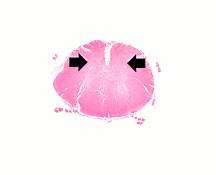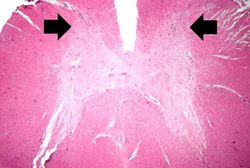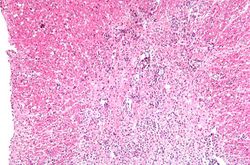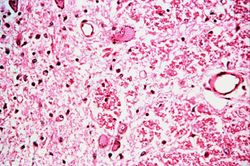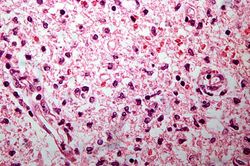Difference between revisions of "IPLab:Lab 8:Poliomyelitis"
Seung Park (talk | contribs) |
Seung Park (talk | contribs) (→Virtual Microscopy) |
||
| (8 intermediate revisions by the same user not shown) | |||
| Line 1: | Line 1: | ||
== Clinical Summary == | == Clinical Summary == | ||
| − | Six days before his death, this 31-year-old white male became acutely ill with fever followed by an ascending paralysis which began in his feet. Three days later he was hospitalized because of difficulty in breathing. A lumbar puncture was performed and the patient's spinal fluid contained increased protein and polymorphonuclear leukocytes (4.30 PMNs/ | + | Six days before his death, this 31-year-old white male became acutely ill with fever followed by an ascending paralysis which began in his feet. Three days later he was hospitalized because of difficulty in breathing. A lumbar puncture was performed and the patient's spinal fluid contained increased protein and polymorphonuclear leukocytes (4.30 PMNs/mm³). He died on the third hospital day. |
== Autopsy Findings == | == Autopsy Findings == | ||
| Line 15: | Line 15: | ||
File:IPLab8Polio5.jpg|This is another high-power photomicrograph of the anterior horn with inflammatory cell infiltrate and total loss of neurons. | File:IPLab8Polio5.jpg|This is another high-power photomicrograph of the anterior horn with inflammatory cell infiltrate and total loss of neurons. | ||
</gallery> | </gallery> | ||
| + | |||
| + | == Virtual Microscopy == | ||
| + | === Poliomyelitis === | ||
| + | <peir-vm>IPLab8Polio</peir-vm> | ||
| + | |||
| + | === Normal Spinal Cord === | ||
| + | <peir-vm>IPLab8Polio-Normal_cord</peir-vm> | ||
== Study Questions == | == Study Questions == | ||
* <spoiler text="How does poliovirus cause cell death?">Poliovirus replicates inside neurons and causes lysis of the cell.</spoiler> | * <spoiler text="How does poliovirus cause cell death?">Poliovirus replicates inside neurons and causes lysis of the cell.</spoiler> | ||
* <spoiler text="What is the mode of transmission of poliovirus?">Poliovirus is an enterovirus that is usually acquired from contaminated water. It has been effectively controlled by immunization; however, among the nonimmune it causes a nonspecific gastroenteritis. In a small fraction of the vulnerable population, it can invade the nervous system where it attacks lower motor neurons.</spoiler> | * <spoiler text="What is the mode of transmission of poliovirus?">Poliovirus is an enterovirus that is usually acquired from contaminated water. It has been effectively controlled by immunization; however, among the nonimmune it causes a nonspecific gastroenteritis. In a small fraction of the vulnerable population, it can invade the nervous system where it attacks lower motor neurons.</spoiler> | ||
| + | |||
| + | == Additional Resources == | ||
| + | === Reference === | ||
| + | * [http://emedicine.medscape.com/article/967950-overview eMedicine Medical Library: Pediatric Poliomyelitis] | ||
| + | * [http://www.merckmanuals.com/professional/infectious_diseases/enteroviruses/poliomyelitis.html Merck Manual: Poliomyelitis] | ||
| + | * [http://www.polioeradication.org/ The WHO: Global Polio Eradication Initiative] | ||
| + | |||
| + | === Journal Articles === | ||
| + | * Alexander L, Birkhead G, Guerra F, Helms C, Hinman A, Katz S, LeBaron CW, Modlin J, Murphy TV; National Vaccine Advisory Committee-Advisory Committee on Immunization Practices Joint Working Group; Centers for Disease Control and Prevention. [http://www.ncbi.nlm.nih.gov/pubmed/15583093 Ensuring preparedness for potential poliomyelitis outbreaks: recommendations for the US poliovirus vaccine stockpile from the National Vaccine Advisory Committee (NVAC) and the Advisory Committee on Immunization Practices (ACIP)]. ''Arch Pediatr Adolesc Med'' 2004 Dec;158(12):1106-12. | ||
| + | |||
| + | === Images === | ||
| + | * [{{SERVER}}/library/index.php?/tags/2149-polio PEIR Digital Library: Polio Images] | ||
| + | * [http://library.med.utah.edu/WebPath/CNSHTML/CNSIDX.html#7 WebPath: CNS Pathology: Acquired and Congenital Degenerative Diseases] | ||
{{IPLab 8}} | {{IPLab 8}} | ||
[[Category: IPLab:Lab 8]] | [[Category: IPLab:Lab 8]] | ||
Latest revision as of 16:30, 3 January 2014
Contents
Clinical Summary[edit]
Six days before his death, this 31-year-old white male became acutely ill with fever followed by an ascending paralysis which began in his feet. Three days later he was hospitalized because of difficulty in breathing. A lumbar puncture was performed and the patient's spinal fluid contained increased protein and polymorphonuclear leukocytes (4.30 PMNs/mm³). He died on the third hospital day.
Autopsy Findings[edit]
At autopsy, the thoracic and lumbar portions of the spinal cord were softer than normal and focally hemorrhagic.
Images[edit]
Virtual Microscopy[edit]
Poliomyelitis[edit]
Normal Spinal Cord[edit]
Study Questions[edit]
Additional Resources[edit]
Reference[edit]
- eMedicine Medical Library: Pediatric Poliomyelitis
- Merck Manual: Poliomyelitis
- The WHO: Global Polio Eradication Initiative
Journal Articles[edit]
- Alexander L, Birkhead G, Guerra F, Helms C, Hinman A, Katz S, LeBaron CW, Modlin J, Murphy TV; National Vaccine Advisory Committee-Advisory Committee on Immunization Practices Joint Working Group; Centers for Disease Control and Prevention. Ensuring preparedness for potential poliomyelitis outbreaks: recommendations for the US poliovirus vaccine stockpile from the National Vaccine Advisory Committee (NVAC) and the Advisory Committee on Immunization Practices (ACIP). Arch Pediatr Adolesc Med 2004 Dec;158(12):1106-12.
Images[edit]
- PEIR Digital Library: Polio Images
- WebPath: CNS Pathology: Acquired and Congenital Degenerative Diseases
| |||||
Normally, there should be no PMNs in a patient's spinal fluid.
An infiltrate is an accumulation of cells in the lung parenchyma--this is a sign of pneumonia.
